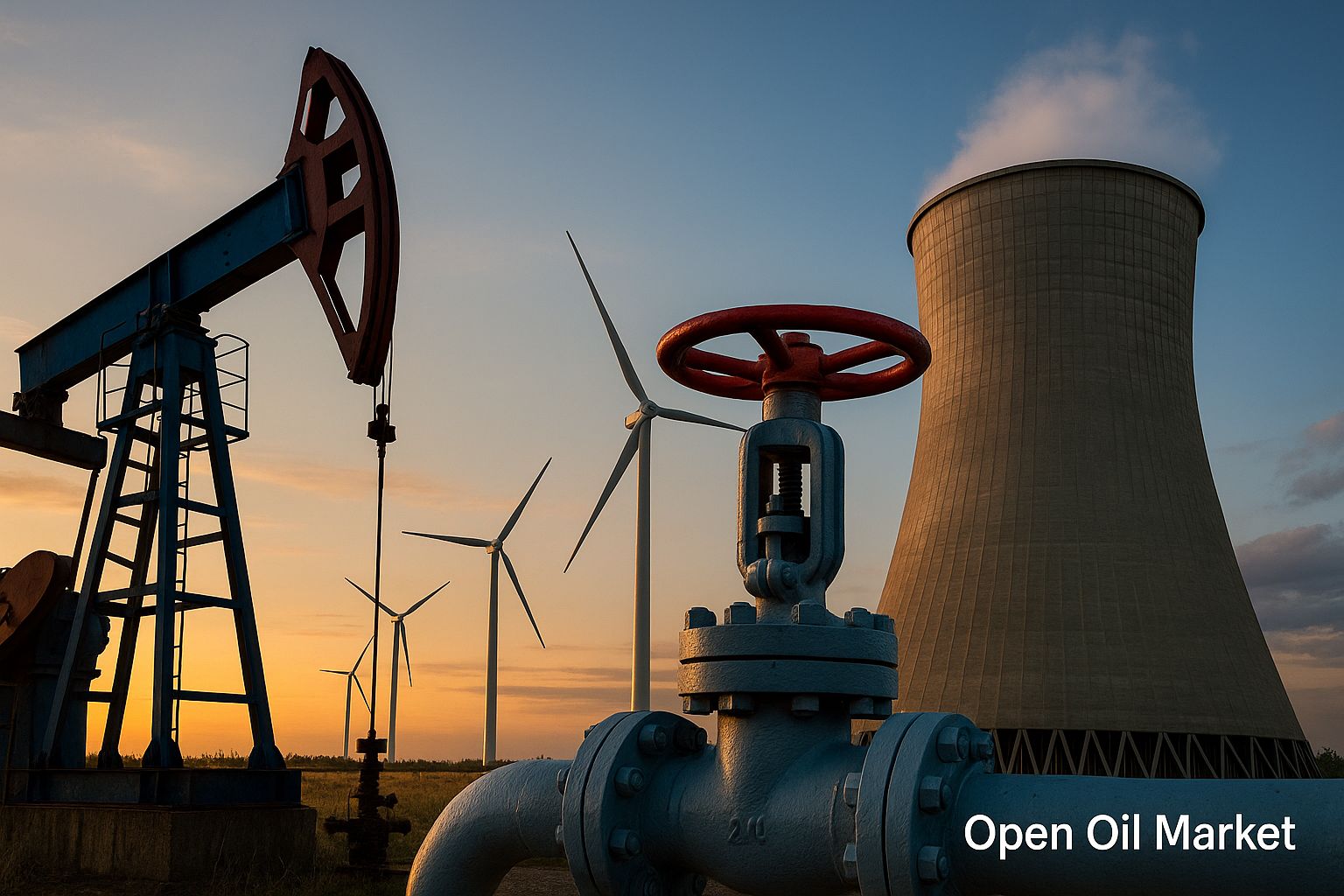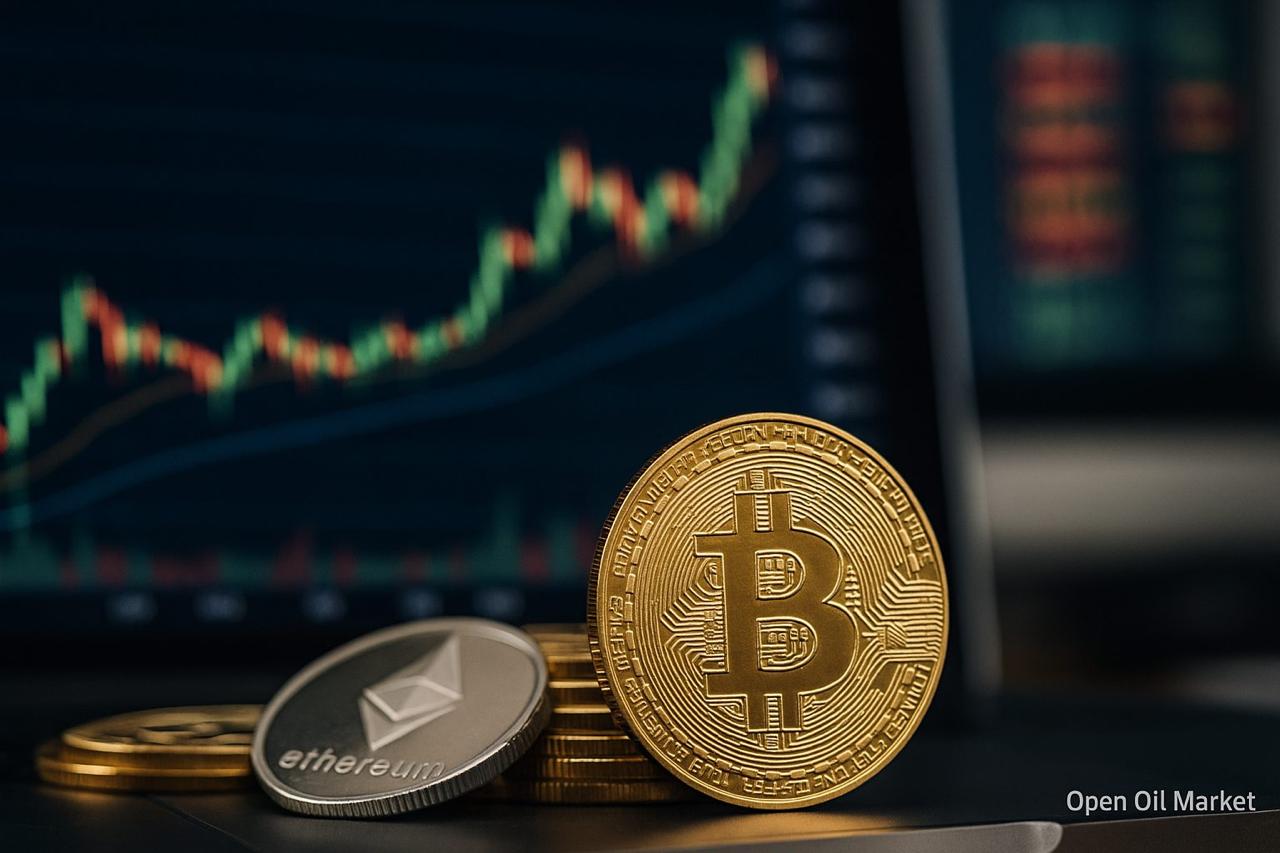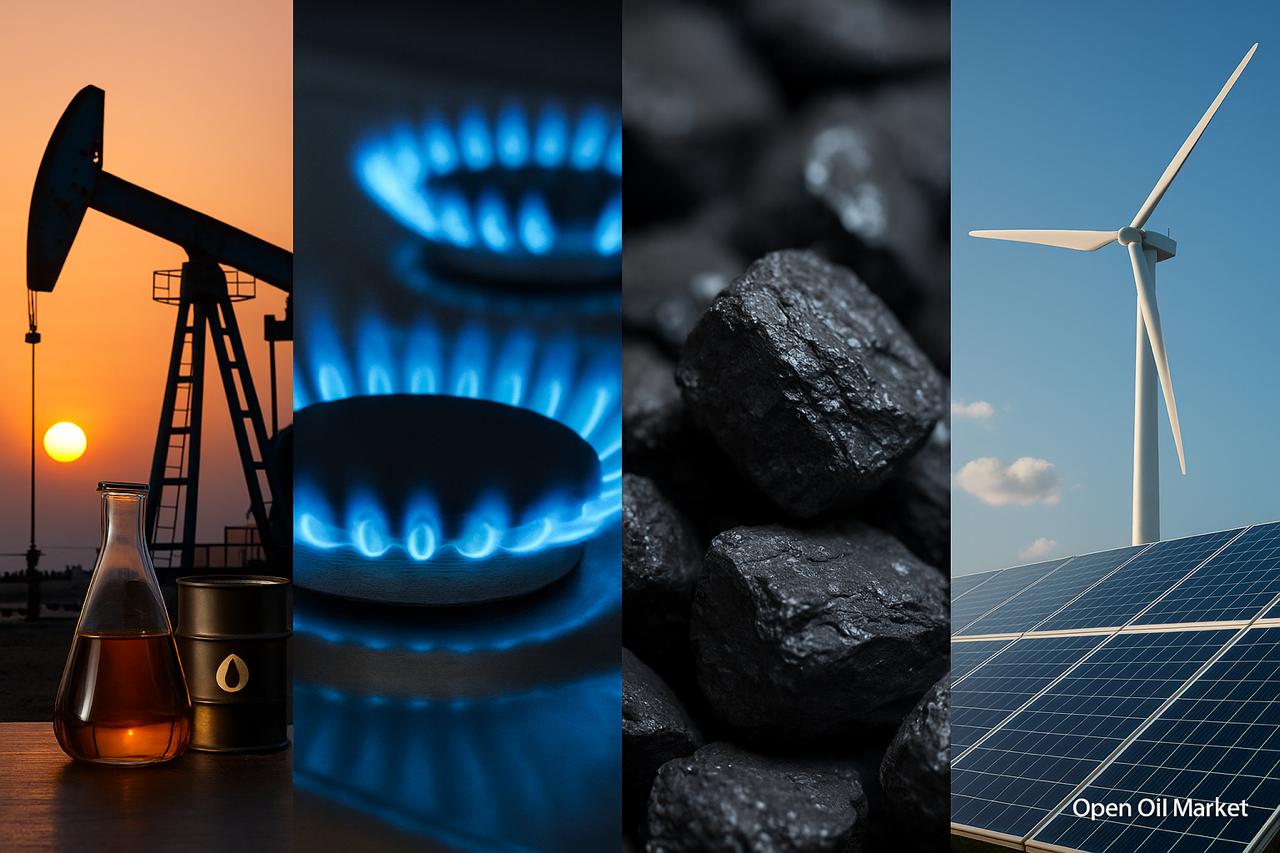
Current News in the Fuel and Energy Sector as of November 3, 2025: Oil Production Growth, Record Gas Reserves in Europe, Renewable Energy Development, and Stabilization of Oil Products Market. Analysis of Global Trends in Energy, Investments, and Geopolitical Factors.
The start of the workweek in the global fuel and energy sector is marked by a combination of conflicting trends. On one hand, there is a continued gradual increase in "black gold" production from OPEC+ countries and other major producers, while oil prices remain in a moderate range (Brent around $60–65 per barrel). On the other hand, Europe and Asia are experiencing record fuel reserves: underground gas storage facilities are filled to over 95%, and operating renewable energy sources are hitting historical records. A strategic trade truce between the United States and China has improved forecasts for energy demand, but ongoing geopolitical tensions and Western sanctions policy pose risks to supply. In Russia, the domestic fuel market is stabilizing after the autumn shock: gasoline and diesel production has been restored, and wholesale prices are decreasing thanks to government measures (a temporary export ban on fuel).
- OPEC+ officially increased production quotas by approximately 137,000 barrels/day in November, with alliance members preparing for a similar step in December.
- Global oil prices remain at mid-2025 levels: Brent stabilized around $60–65/barrel, with volatility persisting amid trade news and sanctions actions.
- The gas sector is entering winter with unprecedented high reserves: gas storage in the EU is over 95% full, keeping spot gas prices around ~30 €/MWh (less than half of the peaks in 2022).
- The global energy transition is gaining momentum: investment in renewable energy sources has hit new records, and the share of wind and solar power in electricity generation continues to grow.
- The Russian oil products market is benefiting from emergency measures that are alleviating the crisis: wholesale prices for gasoline and diesel are falling, and there is no fuel shortage.
Oil Market: Supply Surplus and Moderate Price Growth
The global oil market remains in a position of slight surplus. OPEC+ countries are gradually expanding production: the alliance officially raised quotas by +137,000 barrels/day in November and is preparing for a similar increase in December. The U.S., Brazil, and other independent producers continue to ramp up production to record levels. Amidst this, global demand growth is slowing — the International Energy Agency (IEA) anticipates an increase of less than +0.7 million barrels/day in 2025, which is significantly lower than last year's pace.
- OPEC+ and global supply. The OPEC+ alliance gradually eased voluntary restrictions by 2.2 million barrels/day between October and November, returning approximately 137,000 barrels/day. December's quota increase is expected to be comparable. This reinforces stock accumulation and limits the potential for rapid price growth.
- Demand and economy. Despite concerns over overproduction, the U.S.-China trade "truce" creates new hopes for rising energy consumption. However, global demand is currently growing sluggishly — financial markets are anticipating moderate economic growth. Increased energy conservation and the spread of electric vehicles are also suppressing oil consumption growth.
- Pricing. After a plunge to lows last week (Brent dropped to ~$60), oil quotes rebounded to around $65 per barrel due to optimism regarding demand and new sanctions against Russian exporters. Overall, average oil prices remain below earlier year levels ($60–65/barrel), with periodic spikes driven by geopolitics and inventory news.
Gas Market: Record Reserves and Low Prices
The gas sector, at the end of October, is exhibiting relative stability. Most European energy companies concluded the summer season with record fuel reserves in underground storage (over 95%), easing the demand for additional supplies and keeping spot gas prices at low levels (around 30–35 €/MWh). The winter period has started with warm weather, leading to lower-than-usual gas consumption, while additional LNG supplies and side shipments from the U.S. and Qatar have ensured a reliable resource reserve.
- Record European reserves. The EU enters the heating season with almost full gas storage — around 95–97%. This minimizes the risk of energy deficits and limits price volatility for "blue fuel."
- Shifts in gas flows. A significant event of the past week was the Italian Eni's refusal to supply gas through the "Blue Stream" pipeline (to Turkey) under a contract with Botas. Concurrently, Russian pipeline gas exports to Turkey rose by 26% from January to July 2025. These changes indicate a redirection of flows: part of the fuel is moving east and to Turkey, while decreased sales in Europe are compensated by alternate channels.
- LNG market development. The global LNG market remains oversupplied: large volumes of liquefied gas from the U.S., Qatar, and Australia are not lacking buyers, which continues to apply downward pressure on gas prices in Asia and Europe. In particular, Asian demand was relatively weak in the fall following a cold summer, which means LNG prices also remain moderate.
Electricity and Renewables: Record Investments and Capacity Growth
The energy transition is reaching new heights: investment in renewable energy worldwide is hitting new records. According to industry analysts, global investments in “clean” energy rose by approximately 10% in the first half of 2025 compared to last year, exceeding $380 billion. Investments in small solar installations and other distributed renewables are showing especially high growth, despite declining funding for large infrastructure projects in the U.S.
- Growth of "green" capacity. In 2025, record capacities of wind and solar power plants are being introduced: China plans over 300 GW of new solar capacity (more than double from the previous year) and over 140 GW of wind energy. Europe, the U.S., India, and other markets are also increasing their renewable energy volumes, raising the share of wind and solar in their energy systems.
- Investment transition. Investor capital is gradually shifting towards renewables: in the U.S., investment in “clean” energy has decreased due to regulatory policy, while in the EU and Asia-Pacific, it has significantly increased. This reflects growing investor demand for low-carbon projects with stable returns.
- Innovations and infrastructure. Concurrently, developments in energy storage, “green” hydrogen, and efficient network equipment are progressing. Several countries are implementing transition incentive programs: for example, the EU is discussing new mechanisms for carbon price control (potential cap at €45/t CO₂), while governments in Asia are actively subsidizing renewable projects.
Coal Sector: Seasonal Demand Surge and Transitional Trends
The coal market is showing mixed dynamics: after summer peaks, the growth in its consumption has somewhat quieted. In August–September, under the influence of anomalous heat in China and India, coal generation temporarily increased, supporting prices: imports to China and India surged to multi-month highs, and prices for the most sought-after grades of thermal coal hit local peaks. However, this seasonal uptick is likely to be temporary.
- Increased demand in Asia. In China, the rise in summer electricity demand and reduced hydropower generation stimulated increased coal imports. A weak increase in domestic production (due to safety restrictions in mines) further supported purchases. A similar trend was observed in India, where foreign coal imports significantly rose during the summer.
- Long-term demand decline. Despite a short-term price recovery (up to $40–70 per ton for popular grades), mid-term trends remain bearish: energy transition and large-scale integration of wind/solar energy in China, Europe, and the U.S. systematically reduce coal's share in generation. For instance, in the first half of 2025, over 300 GW of new renewables were installed in China, fundamentally altering fossil fuel demand structure.
- European outlook. In the EU, coal is gradually being phased out in line with climate goals, although some regions (Eastern Europe, the Balkans) still reserve it for peak loads. Overall, coal markets remain relatively balanced, with prices stable amidst moderate global demand.
Fuel Market and Refineries: Price Growth Slowdown and Stabilization
The Russian oil products market is adapting to new conditions following the autumn price "jump." By the end of October, gasoline and diesel production has been restored to pre-crisis levels, and temporary export restrictions on fuel (gasoline export limits) have helped increase domestic reserves. Thanks to these measures, wholesale prices for AI-92 and diesel are declining from peaks, and fuel supply at gas stations exceeds the tense months of the past.
- Global and domestic factors. The situation is influenced by a mix of internal and external factors: on one hand, global oil product quotes have decreased from summer highs, while on the other, the price collapse in the domestic market has persisted under the influence of rising excise taxes and inflation. Experts predict that in November, retail price growth for gasoline in Russia will slow down (for example, AI-92 is expected to trade around 61–63 ₽/l), but won’t turn negative due to the aforementioned fundamental reasons.
- Refineries and logistics. Oil refineries have restored their load, but some capacities were halted for repairs in September, which previously exacerbated shortages. Now that large maintenance is completed, logistics chains are normalizing, further alleviating price pressure. There is a noticeable easing of speculative demand and a reduction in deficit expectations.
- Regional dynamics. In remote regions of the Russian Federation, prices traditionally remain higher than the national average due to high logistical costs. However, the overall trend of gradual decline in the growth rates of gasoline and diesel pricing is being observed universally. Government measures (tax breaks, price monitoring) are helping to keep the situation under control.
Geopolitics and Sanctions: Trade Truces and Energy Security
Energy markets remain sensitive to political factors and the sanctions environment. The interaction of major powers continues to exert a key influence: the trade agreement reached on October 30 between the U.S. and China has reduced tensions in the global economy and supported energy demand forecasts. At the same time, anti-Russian sanctions persist and complicate the situation for certain players: the U.S. has imposed new restrictions on the subsidiaries of "Rosneft" and "LUKOIL," and the EU is tightening its embargo on Russian LNG.
- International agreements. Trade "truces" and regional agreements (for example, between major economies in Asia and the West) have a short-term impact on energy markets. Optimism following negotiations stimulates investors' risk appetite for commodity assets, including oil and coal.
- Sanction pressure. Sanctions on "blue fuel" and oil products continue to create structural distortions. Northern and eastern routes (pipelines, tankers) facilitate the continued export of Russian energy resources to Asia, but new measures (such as additional tariffs or shipping insurance restrictions) still introduce uncertainty. Risk premiums in oil and gas prices arise from this situation.
- Regional conflicts. Conflicts in the Middle East, political instability, and other regional factors have not yet led to new price shocks but remain a potential backdrop for the market. Investors are closely monitoring the situation in Iraq, Libya, as well as the progress of climate negotiations (preparations for COP30 in November in Brazil), which may reflect on the "green" transition strategy and demand for traditional energy carriers.
Investments and Prospects in the Fuel and Energy Sector: A Sustainable Transition Trend
Investors continue to redistribute capital towards "clean" energy: funds and companies are increasingly financing projects in the field of renewable energy and energy efficiency. Industry analysts estimate that investments in renewables in 2025 will significantly exceed last year's figures, particularly in solar and wind generation. The U.S., Europe, and Asia are developing new support mechanisms: the European Union is successfully implementing green bonds, while Asia is realizing large auctions for “green” projects.
- Changing investment portfolios. Major investors (pension funds, mutual funds) are gradually reducing their exposure to hydrocarbon-related assets and increasing investments in "green" technologies. This is reflected in the capitalizations of renewable energy companies and the increasing number of successful IPOs in the energy sector.
- Infrastructure financing. Despite the general shift to renewables, financing for traditional energy remains: banks and funds support the construction of pipelines, expansion of LNG terminals, and technological upgrades of refineries (to produce cleaner fuels). At the same time, new "green" loans for low-emission energy projects are emerging.
- Promising technologies. Emphasis is placed on so-called technologies of the "clean hydrocarbon age": carbon capture and storage (CCS), hydrogen production from gas, and biofuels. These areas are also attracting significant investments as part of a strategy for the long-term sustainability of the energy sector.
Outlook and Forecasts: What to Expect by Year-End
The short-term outlook for energy markets overall remains moderately positive. It is expected that the current oil supply surplus will continue until the end of 2025, which will limit price growth. Brent is anticipated to trade in the range of $60–70 per barrel in Q4, while gas prices will remain low due to high stock accumulation before winter. Electricity demand growth will occur due to winter loads, but thanks to modern technologies and supply diversification, disruptions are not foreseen.
In Russia, the government will continue to monitor fuel and electricity price dynamics to avoid повторных кризисов. On the international level, the main drivers will continue to be geopolitics and energy trends: the outcomes of climate negotiations, the development of trade routes, and investments in new technologies will determine market behavior in the near future. Investors and fuel and energy sector participants should prepare for the possibility that 2026 will bring further integration of renewable energy and moderate demand for fossil fuels, along with potential price corrections in response to changing macroeconomic expectations.




